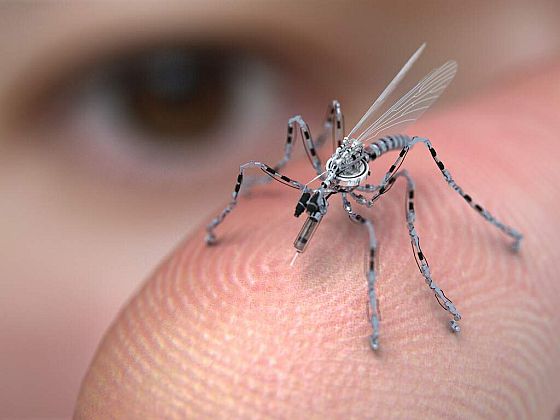
Mockup of a mosquito drone that could be used for gathering DNA samples from unwitting targets.
Lev Grossman writes: Drones don’t care who they work for. They’ll spy for anyone, and as they get cheaper and more powerful and easier to use, access to military-grade surveillance technology will get easier too. Voracious as they are for information, drones could take a serious chunk out of Americans’ already dwindling stock of personal privacy. It’s certainly not legal to fly a drone up 10 stories to peer through the curtains into somebody’s bedroom, but it’s just as certain that somebody’s going to do it, if they haven’t already. Last February an animal-rights group in South Carolina launched a drone to watch a group of hunters on a pigeon shoot on private property. The hunters promptly shot it down. It might be America’s first case of human-on-drone violence, but it won’t be the last.
Whatever happens on the civilian front, the ongoing dronification of the U.S. military is barreling ahead. The Predator has already been superseded by the larger, faster, more powerful Reaper, which is in turn looking nervously over its shoulder at the even larger, jet-powered Avenger, currently in the testing phase.
The U.S.’s skunkworks are disgorging drones in a bizarre profusion — like Darwin’s finches, they’re evolving furiously to fill more and more operational niches and creating new ones as they go. Already soldiers carry hand-launchable Raven surveillance drones and kamikaze Switchblade drones for targeting snipers. The K-MAX unmanned helicopter ferries cargo around Afghanistan for the Marines. The Navy’s SeaFox, a single-use underwater drone, is hunting for Iranian mines in the Persian Gulf. The Army is testing a Long Endurance Multi-Intelligence Vehicle, essentially a 300-ft.-long unmanned blimp designed to squat over a battlefield at high altitude for weeks at a time. (Its manufacturer, Northrop Grumman, promises “more than 21 days of unblinking stare.”) DARPA has fielded a tiny drone that mimics the flight of a hummingbird, and it’s mulling a network of deepwater drones that would dwell on the seafloor but — like Godzilla — rise to the surface in times of need.
Drones are learning to think for themselves. Those University of Pennsylvania drones are already semiautonomous: you can toss a hoop in the air and they’ll plot a trajectory and fly right through it. (Whether or not you count Google’s self-driving cars as people-carrying, highway-borne drones seems like a question of semantics.) They’re also gaining endurance. In June, Boeing tested a liquid-hydrogen-powered drone called the Phantom Eye that’s designed to cruise at 65,000 ft. for four days at a time. Boeing’s Solar Eagle, which has a 400-ft. wingspan, is scheduled for testing in 2014. Its flights will last for five years.
This technology will inevitably flow from the military sphere into the civilian, and it’s very hard to say what the consequences will be, except that they’ll be unexpected. Drones will carry pizzas across towns and drugs across borders. They’ll spot criminals on the run and naked celebrities in their homes. They’ll get cheaper to buy and easier to use. What will the country look like when anybody with $50 and an iPhone can run a surveillance drone? Last fall the law schools at Stanford and NYU issued a report, “Life Under Drones,” which was based on 130 interviews with Pakistanis. It makes for unsettling reading. “Drones are always on my mind,” said a man from Islamabad. “It makes it difficult to sleep. They are like a mosquito. Even when you don’t see them, you can hear them. You know they are there.”


“… it’s very hard to say what the consequences will be, except that they’ll be unexpected.”
I’ve said this many times already: All it takes is one wayward drone to find its way into a commercial airline’s turbofan, and that is the end of it. Or the program will be seriously circumscribed. Worse yet, since you make the point that “…access to military-grade surveillance technology will get easier too…”, it doesn’t seem far-fetched to imagine a terrorist actually targeting a commercial airliner’s turbofan with his own homemade drone, (possibly using even stealth technology?).
That’s when the real war starts here at home. Those who sit in their ivory towers giving out their prognostications, have no idea what they are proposing in regards to unleashing these things. The really scarey part, will be when the A.I. takes over, refusing to follow the brains who think they can control to things. Are they in for a surprise!